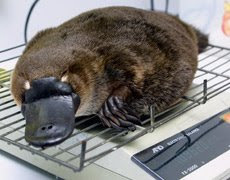News Bot
Very Well-Known Member
- Joined
- May 6, 2008
- Messages
- 1,760
- Reaction score
- 1
Published: Fri, 09 May 2008 13:27:00 +0000
Source: Reptile Related News
Scientists still don't know what to make of the duck-billed platypus, a mammal that lays eggs, has a bill like a bird and can deliver venom like a reptile. But they say they are a little closer to understanding the oddball of the animal kingdom with the publication this week of its genome sequence. An international team of researchers says the draft genome sequence of Ornithorhynchus anatinus provides scientists with a valuable resource for comparing the platypus with other mammals, and may allow them to date the emergence of mammalian traits.
"At first glance, the platypus appears as if it was the result of an evolutionary accident. But as weird as this animal looks, its genome sequence is priceless for understanding how fundamental mammalian biological processes have evolved," Francis Collins, the director of the U.S.-based National Human Genome Research Institute, said in a statement. "Comparisons of the platypus genome to those of other mammals will provide new insights into the history, structure and function of our own genome," he said.
The team found the platypus genome contains about the same number protein-coding genes as other mammals — approximately 18,500 — and shares about 80 per cent of its genes with other mammals whose genes have been sequenced. But it was the differences that scientists were most interested in. Analysis of the genome enabled scientists to match many of the platypus's unusual features with genetic sequences found in other animals, revealing a mammal that was at the crossroads between early mammal-like reptiles and most of the mammals we see today. The genetic analysis revealed, for example, that the platypus had similar milk protein genes to other mammals that produced milk for their offspring, even though it lays eggs and harboured both mammalian and reptilian genes associated with egg fertilization.
Males of the species are also capable of delivering venom through hind leg spurs, and the scientists said they found that reptile and platypus venom proteins both developed similarly but independently. The findings were published in this week's issue of the journal Nature. The consortium of researchers included scientists from the United States, Australia, England, Germany, Israel, Japan, New Zealand and Spain.
Read More...
Source: Reptile Related News
Scientists still don't know what to make of the duck-billed platypus, a mammal that lays eggs, has a bill like a bird and can deliver venom like a reptile. But they say they are a little closer to understanding the oddball of the animal kingdom with the publication this week of its genome sequence. An international team of researchers says the draft genome sequence of Ornithorhynchus anatinus provides scientists with a valuable resource for comparing the platypus with other mammals, and may allow them to date the emergence of mammalian traits.
"At first glance, the platypus appears as if it was the result of an evolutionary accident. But as weird as this animal looks, its genome sequence is priceless for understanding how fundamental mammalian biological processes have evolved," Francis Collins, the director of the U.S.-based National Human Genome Research Institute, said in a statement. "Comparisons of the platypus genome to those of other mammals will provide new insights into the history, structure and function of our own genome," he said.
The team found the platypus genome contains about the same number protein-coding genes as other mammals — approximately 18,500 — and shares about 80 per cent of its genes with other mammals whose genes have been sequenced. But it was the differences that scientists were most interested in. Analysis of the genome enabled scientists to match many of the platypus's unusual features with genetic sequences found in other animals, revealing a mammal that was at the crossroads between early mammal-like reptiles and most of the mammals we see today. The genetic analysis revealed, for example, that the platypus had similar milk protein genes to other mammals that produced milk for their offspring, even though it lays eggs and harboured both mammalian and reptilian genes associated with egg fertilization.
Males of the species are also capable of delivering venom through hind leg spurs, and the scientists said they found that reptile and platypus venom proteins both developed similarly but independently. The findings were published in this week's issue of the journal Nature. The consortium of researchers included scientists from the United States, Australia, England, Germany, Israel, Japan, New Zealand and Spain.
Read More...




